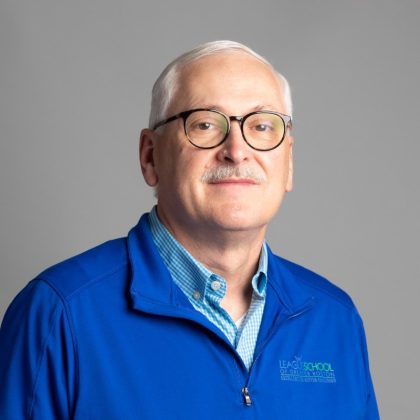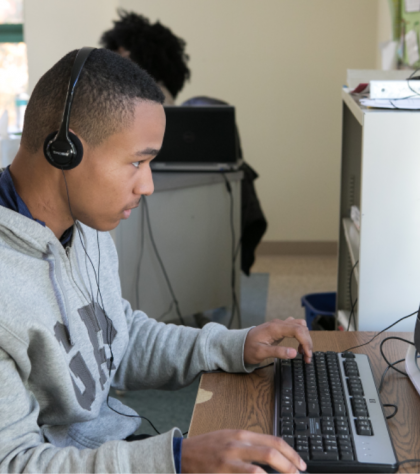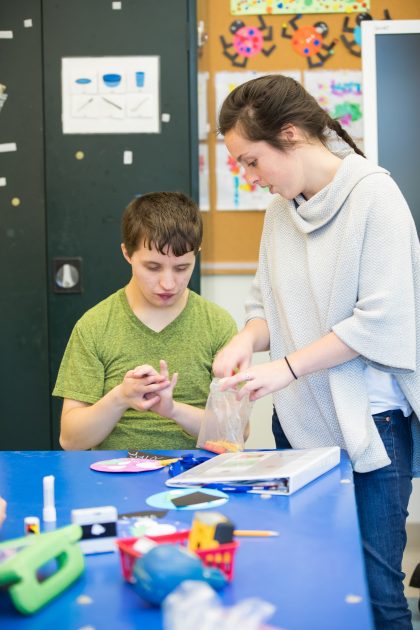In this month’s At the Helm, our Senior Vice President Tracy Marshall spoke with Lawrence Sauer, CEO at League School of Greater Boston. Founded in 1966, the League School of Greater Boston has been a leading educator of children and young adults with Autism Spectrum Disorder for more than 50 years. Tracy and Larry discussed how perceptions of individuals with autism have evolved over time, the changes that still need to occur, and League School’s plans for the future.

Lawrence Sauer
Tracy: You worked in the field of Special Education and Human Services for more than 30 years before joining the League School in 2018. What drives you to do this work?
Larry: I have always wanted a career that feels worthwhile, and for me, that means helping others. That alone has kept me in the field.
Can you explain what it means that the League School follows the SCERTS Model to provide students with an integrated and individualized education?
Most of the other schools that serve students with autism use the ABA Model, which stands for Applied Behavior Analysis. And while we do have board-certified behavioral analysts here at League School, we really focus on a multi-disciplinary approach. Each of our student’s teams have, in addition to a behavior analyst, a clinician, an occupational therapist, a speech and language therapist, an IEP (Individualized Education Program) coordinator, and of course a special education teacher. We want to support the whole student.
And that is possible through the SCERTS Model. SCERTS stands for:
 Social Communication – Our students cover a wide range of the autism spectrum, from students who graduate from high school and go on to post-secondary education, to students who need hand-over-hand assistance with basic life skills. However, no matter where they fall on that spectrum, they have some area of communication and social skills where they require assistance or support. We want our students to be able to communicate effectively and comfortably with anyone they encounter.
Social Communication – Our students cover a wide range of the autism spectrum, from students who graduate from high school and go on to post-secondary education, to students who need hand-over-hand assistance with basic life skills. However, no matter where they fall on that spectrum, they have some area of communication and social skills where they require assistance or support. We want our students to be able to communicate effectively and comfortably with anyone they encounter.- Emotional Regulation – Many of our students have difficulty with regulating their own emotions, as well as their behavioral responses to their emotions. We work to teach them to remain more regulated and at ease, to regulate their own emotions no matter the situation.
- Transactional Supports – In addition to supporting our students, we support their families – so they can better help our students succeed. This is done by teaching the students and families to employ these Transactional Supports.
The SCERTS Model means we can look at and support all aspects of our students. This gives them the best chances of moving on from our school and out into the world successfully.
How has society’s understanding of autism evolved over the years?
For a long time, it was understood through a medical model. It was viewed as something that was “wrong” with individuals and that needed to be fixed or cured. Thankfully, that has changed. I think today people understand autism as part of the spectrum of differences in brain function that anyone may have. Certainly, there are individuals who are more severely impacted by autism than other students. But there’s an understanding that we live in a neurodiverse society, and that means accepting everyone, regardless of where they exist on that spectrum.
 When I first took on the role of CEO, one of my priorities was helping to lead the development of a new strategic plan. A guiding principle of the plan is changing perspectives to understand autism as an aspect of neurodiversity, not a disorder. One of our goals is to create a consulting arm of our school within the next three years. Our consultant group will provide training to our community partners—where our students often volunteer or are employed—on how to be inclusive of and accommodating of neurodiverse individuals. And eventually, the plan is to take the training to other groups beyond our community partners, including businesses, public schools, and larger organizations, such as the scouts. I think it’s a very positive and tactical approach to helping individuals with autism, and we’re all very excited to get this up and running.
When I first took on the role of CEO, one of my priorities was helping to lead the development of a new strategic plan. A guiding principle of the plan is changing perspectives to understand autism as an aspect of neurodiversity, not a disorder. One of our goals is to create a consulting arm of our school within the next three years. Our consultant group will provide training to our community partners—where our students often volunteer or are employed—on how to be inclusive of and accommodating of neurodiverse individuals. And eventually, the plan is to take the training to other groups beyond our community partners, including businesses, public schools, and larger organizations, such as the scouts. I think it’s a very positive and tactical approach to helping individuals with autism, and we’re all very excited to get this up and running.
It’s wonderful to see that progress, and it’s clear that understanding and acceptance of individuals on the spectrum is certainly changing. That said, are there misconceptions that persist?
I think one of the biggest challenges to greater understanding and acceptance is the fact that autism can manifest in such a wide variety of ways. We have students who are significantly impacted by autism and also have an intellectual disability, and as a result, require a great deal of assistance. Then, we have students who have a high IQ, but are non-verbal and are limited in their communications, as well as students who obtain a diploma and may go on to post-secondary education. And I don’t think that most people understand how all of those individuals exist on the spectrum, but in very different ways. There are also commonly instances where people don’t realize an individual even has autism, because they are perceived as high-functioning, so are considered just “different” or “quirky.” Autism impacts individuals so differently, and that isn’t widely understood quite yet.
You mentioned your plans to provide consulting, which will hopefully help your local community—and beyond—better understand, support, and accommodate individuals with autism. What other changes do you think need to occur for greater acceptance?
 Well, another focus of our strategic plan is providing our students with self-advocacy training. We have start providing classes on this topic for students. We want our students to feel empowered and equipped to educate others—whether it be an employer, a peer, someone in their community—on their neurodiversity, how it impacts them, and the kind of support they need. I do want to note that the facilitator for this course is a person who self-identifies as being on the spectrum. We don’t think we can advocate for other employers to hire a neurodiverse workforce if we ourselves don’t do so. We are hopeful that people will be open to learning, and it feels like an opportune time as so many organizations and individuals are deepening their commitment to inclusion.
Well, another focus of our strategic plan is providing our students with self-advocacy training. We have start providing classes on this topic for students. We want our students to feel empowered and equipped to educate others—whether it be an employer, a peer, someone in their community—on their neurodiversity, how it impacts them, and the kind of support they need. I do want to note that the facilitator for this course is a person who self-identifies as being on the spectrum. We don’t think we can advocate for other employers to hire a neurodiverse workforce if we ourselves don’t do so. We are hopeful that people will be open to learning, and it feels like an opportune time as so many organizations and individuals are deepening their commitment to inclusion.
What else is on the horizon for League School?
One of our most exciting—and ambitious—plans is to build a career education site on the four and a half acres of land we own across the street from our school. While a portion of our students pursue post-secondary education after graduating from our program, the majority, around 75-80%, enter the world of work. We want to better support them on this path, so the site will be a like a vocational/technical school for individuals with autism. In addition to academic courses, we will provide classes focused on technology, including everything from data entry to coding; basic trades, such as plumbing, electrical work, and carpentry; and a number of other areas that we’re still exploring, such as cosmetology. There will also be a retail training site, a café that is open to the public, and a garden/craft store. We want to ensure the space is as green as possible, and that our students have access to outdoor space.
It is a really exciting extension of the work we already do—focusing on the student’s whole being and preparing them for success beyond the school—but on a whole different level. We anticipate it taking around three years to be completed, so it will require some time – and of course, funding! It’s an expensive undertaking, so we will be looking to our generous supporters to help make it happen. We will also be focused on expanding our donor base. We are hopeful that this exciting undertaking will attract new supporters who are passionate about helping individuals with autism.
One last question – what advice would you share with fellow leaders?
It’s simple: do what you’re passionate about. I became involved in special education very early in my career, and I never left. Working with young people when they’re still developing, the opportunity for impact is so great; it’s work I truly enjoy. So, find your passion, pursue it, and surround yourself with others who feel the same.
